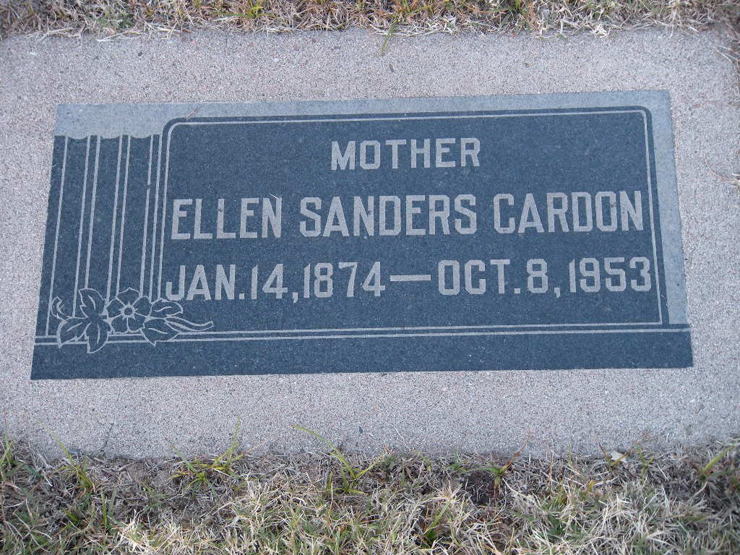1874 – 19532
Compiled by
Brookie Cardon Peterson
October 1997
ELLEN CLYMENA SANDERS CARDON
In attempting to write a brief history of my grandmother, Ellen Clymena Sanders Cardon, I only expect to give a flavoring of her personality and to place it within a simple framework of her life. I have interviewed several of her family and also relied on a few written accounts. I apologize for any inaccurate information. No doubt there are errors in some of our memories. I know that if additional time were spent much more could be discovered about her, but I offer this as a small opportunity to come to know her, the challenges of her life, her likes and her loves and her valiant strength of character.
Brookie Cardon Peterson
ELLEN CLYMENA SANDERS CARDON
Ellen herself, in writing the story of her parents, revealed what little we know of her early life.1 Her parents, John Franklin Sanders and Jane Gibson probably met in Salt Lake City during the 1850s. They were married on March 22, 1858 in Brigham Young’s office. Jane was still only fifteen years old; they did not live together as husband and wife for six more years; she worked as a servant in other homes. They were later sealed in the Endowment House. They lived a rugged frontier life as they added little ones to their growing family.
John fought the Indians in both the Walker and Blackhawk Wars. Yet apparently, he was good to the Indians because when the family were living in Thistle Valley, and he was away from home one night, a band of Indians came through the valley and were about to attack his family. Ellen relates, “–one of the group of some influence said, ‘No, not this house. This house John’s house. He Indians’ friend.’”2They went on further and killed a whole family that night. During this dangerous period Ellen was a young child. Her father paid a tribute to her mother: “He always said mother did as much as he for the war, for she provided the labor and responsibility of family care and upkeep while he was away and that her work and worry was as arduous as his labor and loyalty.”3
After the war was over the family moved back to Fairview, Utah, Ellen’s birth place. There were six children in Ellen’s parents’ family. Besides Ellen there were Phebe, Amanda, Amy, William and Myron [known as Mynie]. Ellen was the fifth child, the youngest daughter, born on 14 January 1874 between the births of her two brothers. She was always known as Ella which I will call her in this account. Her sister Amanda died as a child.
They lived a few years in St. George, and when she was eight they moved to Tonto, called the Tonto Settlement, later called Gisela or Gizelia. It was a desolate, rocky land; her daughter Lucille Matthews calls it “the Place beyond nowhere.” It was in north central Arizona in Gila county, east of Payson. John Sanders was the Presiding Elder in the Church.
Ella writes,
“The dawn of memory, so far as my consciousness of it is concerned, was when we were living at Thistle Valley. I think we did not live there long. When I think of my first home, Fairview is the place. We left Fairview when I was five years old and went to St George. It was at Fairview that I was confirmed a member of the LDS Church by my father, John Franklin Sanders after being baptized by Bishop Granger on the 14th of January, 1882. [It was her eighth birthday. Her older sister and brother were also baptized on this day.] [Note: There is an error here as she says she left Fairview at age five yet was baptized while there.] That was also the year we migrated to the mountain cattle ranges of Arizona. We were joined by a number of relatives and friends, making a company of a dozen or more wagons. My father had been called to settle Tonto Basin, now Gizelia, Gila County, Arizona. We took three months to make the 300 mile trip.”4
In the account she wrote about her parents, Ella records, “After the war was over, father moved back to Fairview, and we lived there until I was five, when we moved to St. George. We remained there until I was eight, when with a group of others, we moved to Tonto.”5
Of Ella’s childhood and adolescence we know almost nothing. One paragraph from her daughter Lucille tells us of a caring woman who had an enormous and far-reaching impact when she befriended and helped to educate Ella.
“Until Mrs. Carrie Stanton, who dearly loved my Mother all the days of her life, came into Tonto from New York with her health-seeking husband, Mother’s schooling had consisted of two or three months in that many years. Mrs Stanton must have been quite a remarkable woman. She inspired Mother with ambition to prepare for teaching and coached her in that preparation.
“It has always been a source of wonder and pride that with no more schooling than that, Mother, with Mrs Stanton to guide her in her studying, prepared herself to take an examination given at Arizona County Seats for those desiring to teach in State schools.
“Globe, the county seat, was a long trip by wagon or horseback from Tonto–one that could not be undertaken by a young girl at any time alone. [The Indians were too dangerous.] It was in the middle of winter when people avoided travel if possible. She almost gave up hope of going. The day before the examination was to begin, in answer to her prayers, a neighbor told her it had become necessary for him and his wife to make the trip to Globe in spite of the weather, and she could go with them.
“After two days of examinations, Mother said, ‘I was awarded a teacher’s certificate good for two years that was renewed for another two years.’ Mother went on to make quite a record with her teaching. She taught 31 years, including ten years in Mexico.”6
She must have taken the teacher’s examination when she was seventeen years old. The Church had encouraged the Sanders and others to settle in the Tonto Basin, but, after nine years of struggle, it was evident there was little promise of any thing but hardship there. The region was very sparsely settled and the members were released from their call to settle it and even encouraged to leave. Ella’s family moved to Mesa, Arizona, in 1891 when she was seventeen years old. Soon afterwards, before she turned eighteen, she got her first school.
Her children remark on what a brilliant woman and dedicated teacher she was. Her first three daughters were born only a year apart, but she continued to teach throughout those years. In the years that followed, as she had five more children, she still went right on teaching. Such perseverance was probably at least partly because of necessity for the income. But she also loved molding boys and girls. Her son Louis says he thinks “they were a lot more than teachers. There was more religion in the schools.”7
It was through her teaching that she met her husband-to-be, Louis Paul Cardon. He was a teacher in Taylor, Arizona, and she was teaching in Snowflake. The schools were small so they would hold parties together to have a larger group. They married on October 9, 1895, in the Temple in Salt Lake City, Utah. Their first daughter, Katie, was born in Taylor, Arizona, the next year, but all their other children were born in Dublan, Chihuahua, Mexico. Her husband had been called by President Wilford Woodruff to go to Dublan to help with the Church School. Their second child, Lucille, was born on their second wedding anniversary in their new surroundings.
There is no way we can know the hardships and heartaches they experienced in that move. At first they built a large one-room building for their home, later expanded to two rooms. In rapid succession four more children were born to them: Gretta, the twins, Paul and Irene, who died the same day they were born, and Louis Sanders. A few years later Marriner Sanders Cardon was born, but died before he was three. The baby of the family was Isabelle born when they had been in Mexico about eleven years.
Just previous to their son Louis’ birth, Louis Paul and Ella had been asked to enter into plural marriage and had faithfully agreed to accept this great responsibility. I would like to quote from Stanley P Cardon, a son of Louis Paul and Irene, his perception of this experience.
“To me, Aunt Ella was a beautiful woman–tall and stately. I always had a great deal of respect for her and feared that I could not measure up to her expectations. She had a keen sense of humor and often said little pleasantries. She and Papa were so obviously devoted to each other that I often wondered what a struggle it must have been to share her husband with two other women. Yet, she never, to my knowledge, showed any sign of resentment.”8
In 1901, Louis Paul Cardon and Edith Jemima Done were married on February 23rd. Over the next two decades they had a family of eight daughters and four sons, five of whom died as young children. Marriner P Cardon recalls observing the relationship of Ella and Edith many years later, and says he was impressed by their great affection for one another. Edith was one of the kindest and most charitable of women.
Tradition has it that these two decided it made too much of a triangle to have two wives in the family, so they told their husband that he should marry again, and, according to Kent Hilton, they said, “We’ve got her picked out for you.” It was Mary Irena Pratt, who was twenty-one and had been helping with the children in their home. That was quite a compliment to Irene as she was known. They were married November 11, 1903. Six sons and three daughters were born to them; all lived to adulthood, but the oldest Parley, died as a young man. Irene was certainly a selfless, wise and noble woman.
Some have a question why these marriages were entered into more than a decade after the Manifesto. It seems that some believed the 1890 Manifesto applied only within the borders of the United States and did not apply to the members in Mexico. Quoting from Joseph F Smith, Patriarch and Preacher, Prophet of God by Francis M Gibbons:
“Among other things, the voluminous testimony in the Smoot hearings [which failed in their purpose to unseat the Utah senator] showed that a comparatively large number of polygamous marriages had been performed after the Manifesto by some who held the sealing power. The most prominent among these was John W Taylor of the Twelve, a son of President John Taylor, who expressed his views of the scope of the Manifesto in these words: ‘I have always believed that the government of the United States had jurisdiction only within its own boundaries, and that the term “laws of the land” in the manifesto meant merely the laws of the United States.’”9
Because of his concerns about the matter, President Joseph F Smith, on April 6, 1904, presented to the conference of the Church what has since become known as the Worldwide Manifesto or the Second Manifesto. In it he stated: “I, Joseph F Smith, President of the Church of Jesus Christ of Latter-day Saints, — hereby announce that all such marriages are prohibited, and if any officer or member of the Church shall assume to solemnize or enter into any such marriage he will be deemed in transgression against the Church and will be liable to be dealt with according to the rules and regulations thereof, and excommunicated therefrom.”10
Some still refused to accept this policy. Among them were John W Taylor and Matthias Cowley of the Twelve. They both resigned from that body on October 28, 1905. Later Elder Taylor was excommunicated and Elder Cowley was disfellowshipped.
We know that Louis Paul Cardon and Ella, Edith and Irene were faithful and true to their beliefs and the leaders of the Church and would not have been disobedient in any way. They were all valiant in temple work until the end of their lives.
THE MEXICO YEARS
The first necessities were building homes, churches and schools. They had to develop industries to supply their own needs. The land was fertile, but they knew they needed a source of reliable water so they undertook to build canals for the purpose of irrigating them. This took a long time to accomplish. Louis Paul did the surveying and his brother Joseph was the chief engineer. Before the task was complete they both, along with many others, got typhoid from drinking contaminated water. They were very ill, and Joseph lost his life at that time.
As the years went by they had the capacity to make fine bricks, and many of their homes were built of beautiful brick. These homes are still sturdily standing and in use a hundred years later [1997]. There was a large Cardon home built, and for a time they all lived together in it, but before long they got a house for each family. Ella lived in the large home when she was in Dublan, but many winters she was away in Diaz or Juarez teaching school to supplement the family income. Her son Louis says she had asthma in Mexico, and couldn’t stay in Dublan at certain times of the year. Sometimes her children went with her, but other times they stayed with the other families. He said that he lived with his aunts more than with his mother. They treated him with great kindness and respect, and he had immense love for them.
Ella “was active as a leader in church activities practically all her life. In Mexico she served on the Mutual Improvement Association Stake Board in the Juarez Stake.”11 Her daughter, Katie Webb, tells us: “She worked with the young people much of the time, and they liked to be with her. She created fun and pleasure for them. She allowed them to have slumber parties at her home, and there was always an eager crowd that came. When I think of Mother, certain pictures come to my mind. I can just see her walking briskly along, concentrating on some idea or project, twirling a bunch of keys on a long chain back and forth around her forefinger. In Mexico, Mother was slender. I felt rather proud of her looks.”12
One thing that must have endeared her to young people was her sense of humor which is universally mentioned by those who knew her. She had a talent to write rhymes, and she wrote new words to many tunes including the “fight” song for Gila Academy. In Mexico the seventh graders used to come to her each year and asked her to write up a catchy spoof on the eighth graders which they would then sing at the annual school dinner of oyster stew and crackers. These always made for a lot of fun for the children for her wit and natural humor were an integral part of the poems and songs she wrote for them. She had a talent to write and conduct school programs.
In the summer time she had an ice cream parlor. The ice came from El Paso, Texas, and might be three hundred pounds when it left, but be only fifty pounds when it reached Dublan. Also if they had hail, they would collect it and store it in straw. Ella made two flavors of ice cream so welcome in the summer heat–the ever popular vanilla flavor and fresh strawberry ice cream with strawberries from their own patch. She sold it by the plate for a nickel or a dime, and became quite famous for it. She also became an expert candy maker. They had a big trunk upstairs in their home. In late fall she would line it with clean paper and make one layer of candy, then cover it with paper, and another layer of candy, another and another until it was filled with candy for Christmas eating. It was delicious–fondant, taffy and chocolate drops.
Throughout her life Ella had a talent with hammer, nails and saw. She liked to build and was capable of constructing a bookcase or even a whole room. “I also remember Mother and her building. When she got things done, we would ask her how in the world she accomplished them. Her answer was invariably, “Oh, I managed.”13 Her granddaughter, Dorcille Webb Cusworth, also spoke of her carpentering ability. In one house Ella made a bedroom in part of their attic. In another, where they really did not have enough bedroom space for the family, she remembers: “It had one bedroom for Mother and Daddy. Helen and I slept on a daybed in the front room and Harvey slept in the garage, which was most unsuitable. Grandmother came down from Mesa and built a moveable room of boards in our back yard area. It was large enough to accommodate a bed, a small desk and a chair. Harvey [her brother] now had a place to sleep which I thought was just grand to have a bedroom of your own! When we moved to another house in which Mother took in boarders, that board room became Mother and Daddy’s outside bedroom.”14
Katie recalls, “Etched deep in my memory are the songs Mother used to sing. The ones I remember best are I Dreamed I Dwelt in Marble Halls, My Sweetheart’s the Man in the Moon, and Jingle Bells.–later she whistled the tune of many songs oftener than singing the words. This continued all her life.
“To me Mother was a brilliant woman who could adapt to any class of people, both the high and the low. I always had great confidence in her abilities. I never remember Mother being critical of other people or saying disparaging things about them, and as children she would never allow us to criticize others.”15
Throughout her life she gave much service. In Mexico, after her family got well from the typhoid, because of the tremendous strain of caring for them, she collapsed and got pneumonia; she was not expected to live. The doctor lived two hours away by horse and buggy, and came to see her every day. He said he’d never had a patient that he wanted to save like he did Ella because she did so much for others. Later Katie wrote of her: “She spent many hours in compassionate service. Jake Bingham was so grateful when Mother came in to help when his family were all down with the Spanish flu. It was during the terrible 1918 epidemic when everyone was so frightened it was almost impossible to get help. He said she was so calm, she gave them strength.”16
FLIGHT TO ARIZONA
In 1911 it became very dangerous to live in the Mexican colonies. There were always bands of Mexicans passing through. Katie said that whether they were Federalists or Rebels didn’t matter; they just took whatever they wanted and got bolder and bolder about accosting the colonists and demanding all their weapons which would have left them defenseless. At last the leaders of the colonies decided it was time for the women and children to leave. Before too long they told the men to leave also. There are many stories about their lives as refugees. They went to El Paso first, then dispersed from there out to other western states where they had family or other contacts.
There was great poverty for years. Everyone had to do all they could to contribute to the livelihood of the families. In Arizona they lived in various communities–Jayne’s Station, Binghampton, Tucson, Mesa and surrounding area. They farmed, taught school, drove a school bus, delivered milk. They kept a garden and milked thirty-three cows to assist with their food supply and bring in extra money. Ella continuously taught in different small towns. Partly this was because there was animosity toward polygamists in Tucson, and she had to stay away from there.
When her last daughter, Isabelle, was the only one at home she was a gospel doctrine teacher. “She taught many classes in auxiliary organizations. She was active in the 4-H Club in Tucson, receiving a medal for this work of which she was very proud. She worked on the Maricopa Stake Board of the Mutual Improvement Association in 1928. From 1932 to 1939 she was on the Relief Society Stake Board in the Maricopa Stake as Visiting Teacher leader. Sister Shupe remarked that she was excellent as a leader and was so much fun.”17
Other comments reveal her diligence and eccentricities. She was exacting as she would weigh and prepare special food for her husband’s diabetic diet. To her daughter’s dismay she kept her money in a pitcher on a shelf in the living room. Ella was gifted as a story teller. She also had a habit of whistling the old songs through her teeth wherever she went, and under her breath as she drove, she still whistled. Even when her short term memory lapsed she could remember all the old poems and songs up until she died.
Another granddaughter tells us: “I remember during this time period [while she was a young child] Grandmother wanted to teach me something about money and the saving of it because she made a chart for me of money received, money spent and the balance after transactions. I was to receive a penny a day. At the end of a few days we would go over my schedule. Maybe this is the start of my eventually becoming an accountant.”18
One older woman remembers as a girl living near their family at this time and says that she knows Ella was a “good housekeeper; her house always looked good.”
Ella’s granddaughter, Gail Wood, remembers that they had two Model A cars in later years. Ella named them Lizzie and Lotta and always spoke of them as though they were alive. Marriner Cardon says that when she was older her children decided she was becoming a dangerous driver. They tried to persuade her to sell her car, but she wouldn’t. Finally they had to steal it!
In her older years she and Louis Paul were temple workers at the Arizona temple. They lived in a little house across the street from the temple. [It was located right behind a home where Isabelle and her children lived.] One of their last pictures was taken on the temple grounds with both of them dressed in their temple white. They often spent their time together studying the scriptures. Most of the hot Mesa summer afternoons they could be found in the cool basement reading to each other. [Gail Wood comments that it was cool, but full of scorpions.] They seemed to never tire of studying with one another and would be thus occupied for hours on end.
“She had what seemed to me thousands of carnations around her house. Grandmother gave me a ceramic sugar bowl and pitcher when I was eight years old, which I treasure to this day, along with the far too few times I was able to spend with her.”19
Ellen Clymena Sanders Cardon was a widow for six years; she died October 8, 1953, and is buried in the Mesa cemetery in Mesa, Arizona. She is remembered by her posterity as being full of integrity, as a caring wife, mother and grandmother, as a valiant and spiritual woman!
Addendum:
After I finished this little paper Gail Wood told me something which should be included. She has in her possession a graduation picture of Ella. She also has a printed program of the graduation. It is dated June 14, 1894, and reads:
Class of 1894 – Arizona Territorial Normal School, Tempe, Arizona.
Class Motto: “Virtue our leader; fortune our companion.”
Surmising: Since we know Ella had a teaching certificate and taught school when she was eighteen, it must be that after that time of teaching, she had a desire for more formal education, so she went to the Territorial Normal school. At her graduation in 1894 she would have been twenty years old. There were fifteen in her graduating class. The picture will be familiar to some of you, though you may never have seen a full-length view of it, but this is what we know of the story behind it. In this history are copies of both picture and graduation program, along with two pictures of Ella much later in her life. Also included are family group sheets with Ella as a child [named Ellen Clymena] and of her as a married woman with a family.
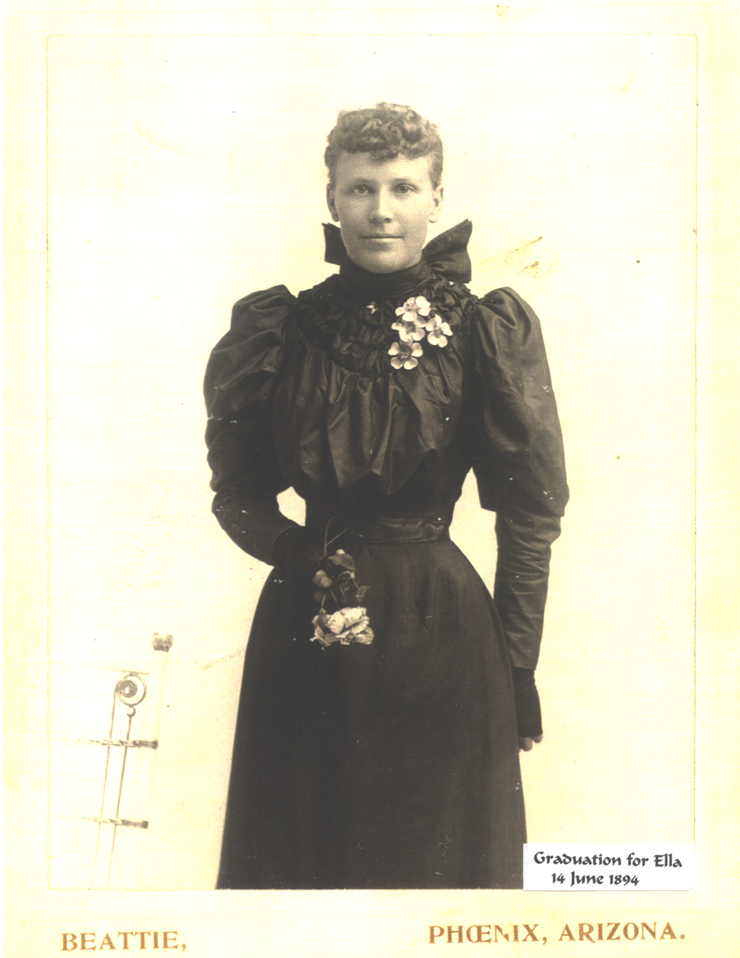

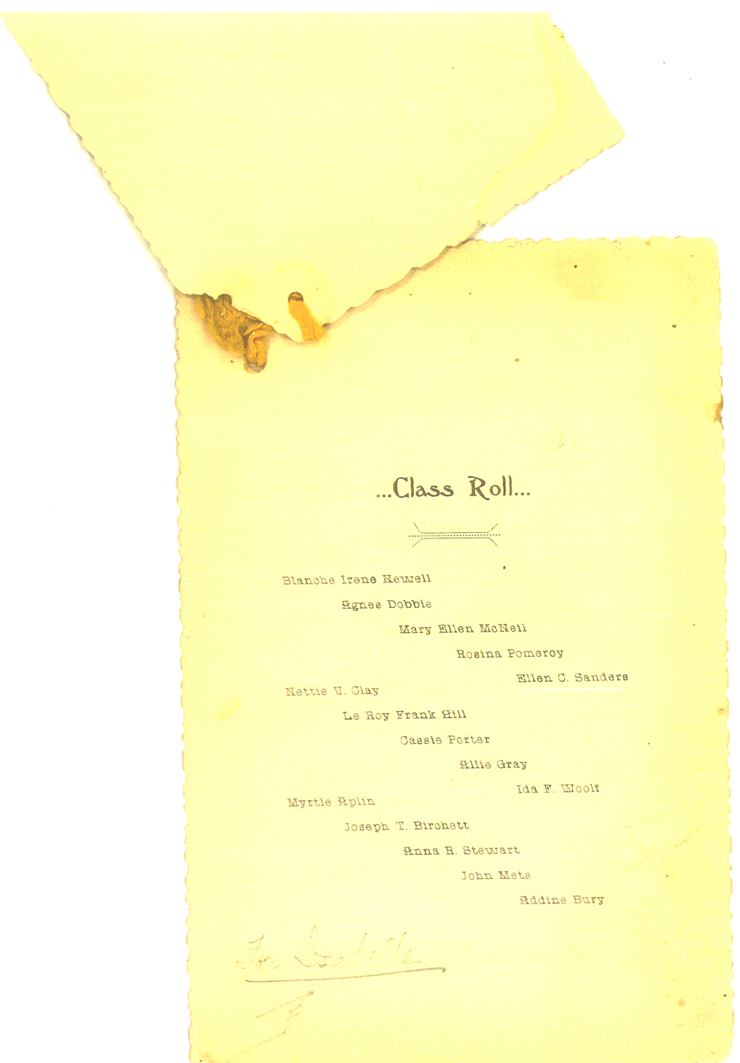


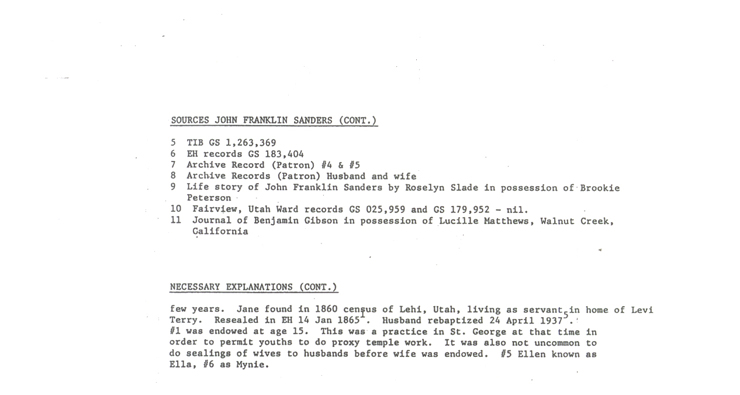

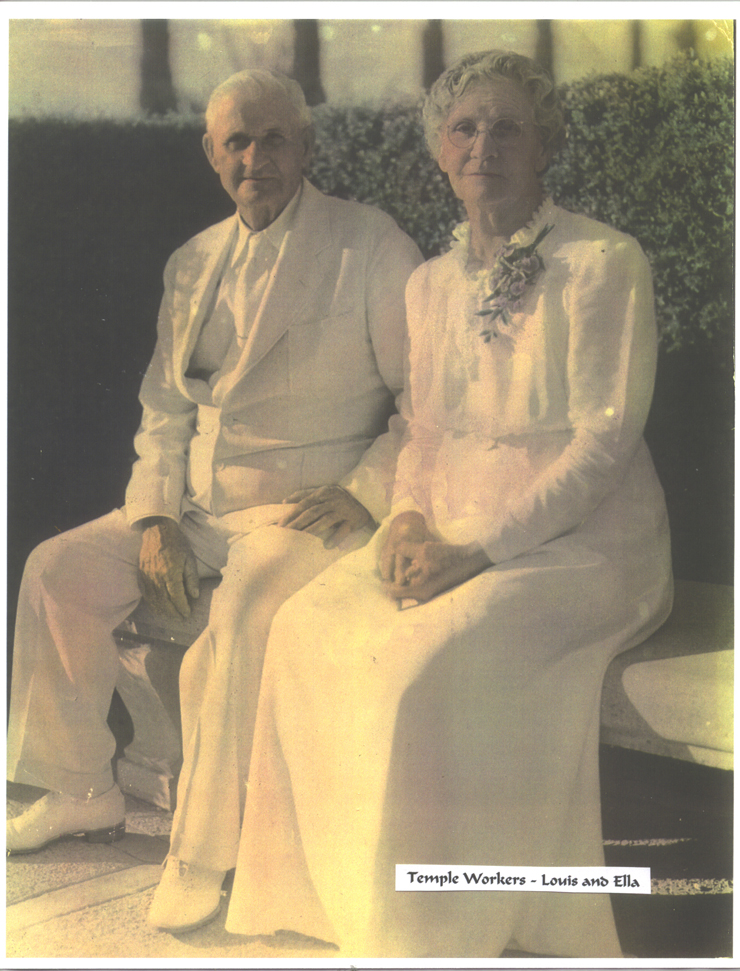
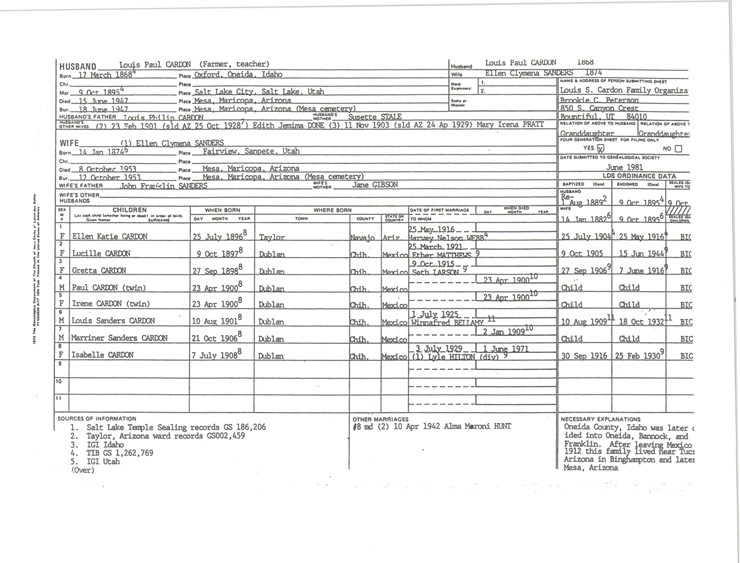

Bibliography:
From Written Unpublished Histories, Oral and Taped Interviews, Written Memories:
Ellen Sanders Cardon – John and Jane Sanders’ Stories
Louis S Cardon – Oral History Transcript
Charles Redd Center for Western Studies, BYU
Marriner Cardon – Memories
Stanley Cardon – Memories and Life History Excerpts
Dorcille Cusworth – Written and oral memories
Francis M Gibbons – Joseph F Smith, Patriarch and Preacher, Prophet of God
Kent Hilton – Memories
Lucille Cardon Matthews – Written reflections – Courtesy of Stanley P Cardon
Taped Interviews – Courtesy of Marriner P Cardon
Katie Cardon Webb – Written reflections – Courtesy of Stanley P Cardon
Taped Interviews – Courtesy of Marriner P Cardon
Gail Wood – Memories
NOTES
1. Note – October 18, 2003 this statement is incorrect. I have learned, since writing this brief, that Ella did write her own life story.
2. John and Jane Sanders’ Stories, by Ellen Sanders Cardon, page 4
3. Ibid page 1.
4. From Ella’sown writings – Courtesy of Stanley P Cardon
5. Ibid not #1 page 4.
6. Lucille Cardon Matthews – Written Feflections
7. Louis S. Cardon – Oral History Transcript
8. Stanley P Cardon – Memories and Life History.
9. John W Taylor in Joseph F. Smith, Patriarch and Preacher, Prophet of God by Francis M Gibbons, page 222
10. President Jospeh F Smith Ibid page 223.
11. Lucille Cardon Mathews – Written Reflections.
12. Katie Cardon Webb – Written Reflections.
13. Katie Cardon Webb – Written Reflections.
14. Dorcille Webb Cusworth – Written Memories.
15. Katie Cardon Webb – Written Reflections.
16. Katie Cardon – written Reflections
17. Lucille Cardon Mathews – Written Reflections
18. Dorcille Webb Cusworth – Written Memories.
19. Dorcille Webb Cusworth – Written Memories.
Burial is in Mesa City Cemetery, Mesa, Maricopa, Arizona

